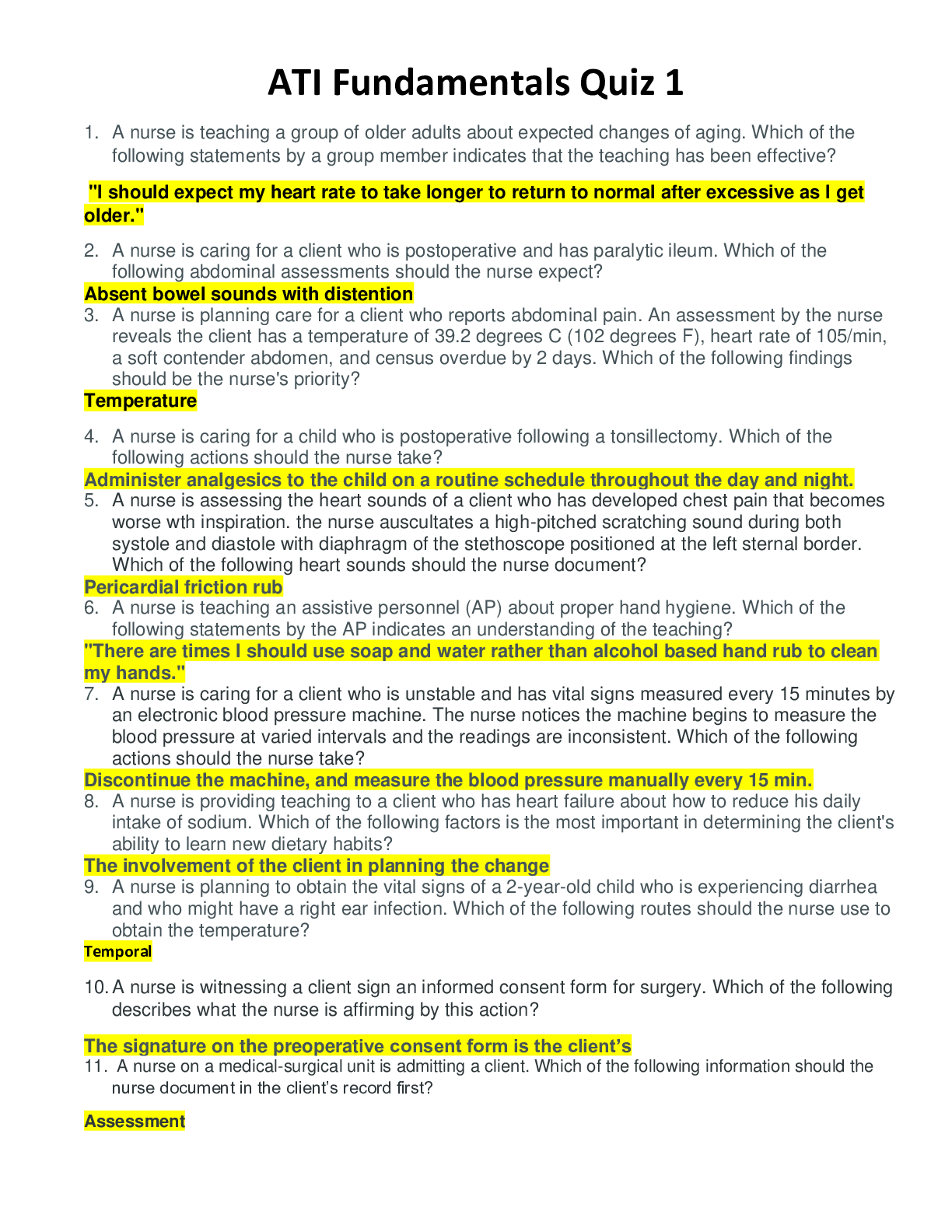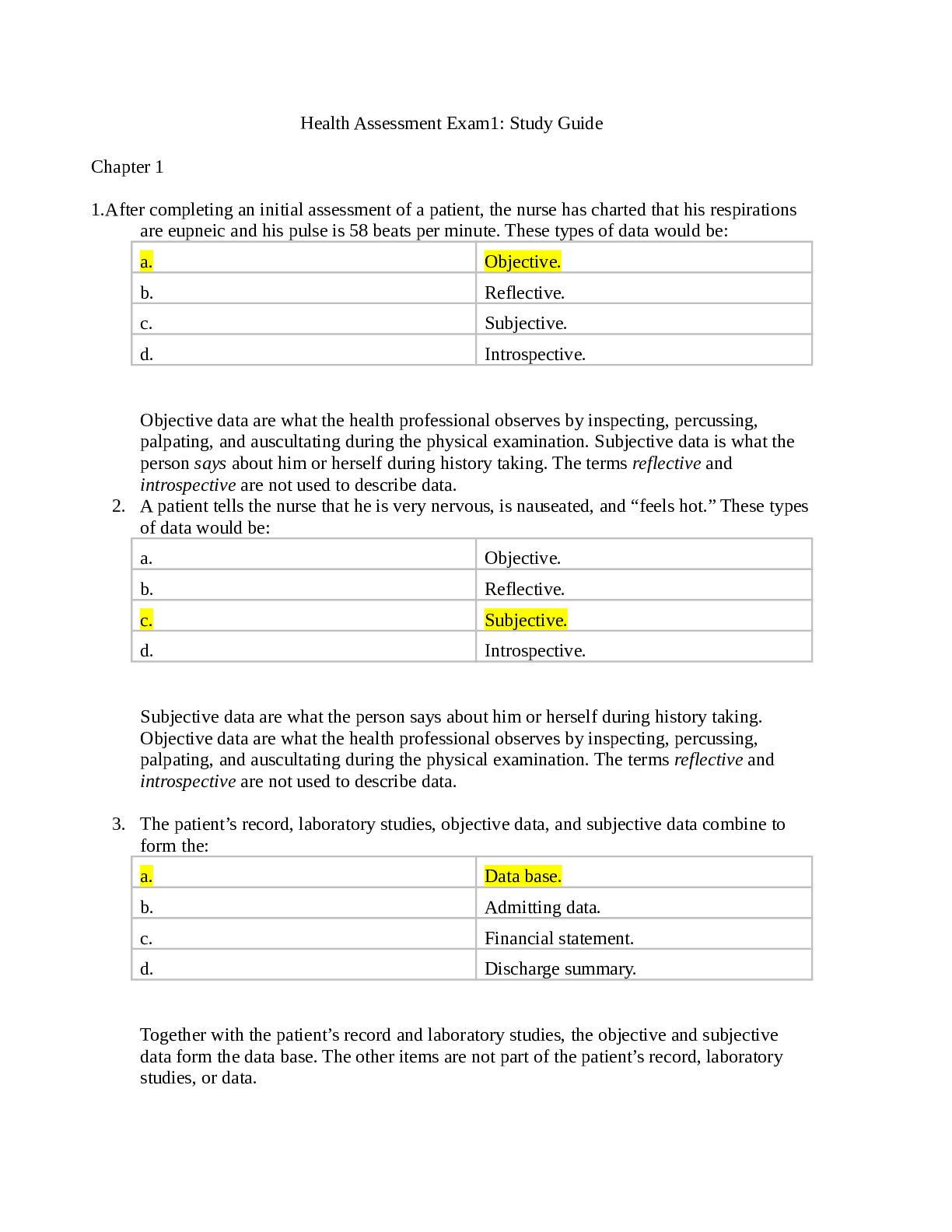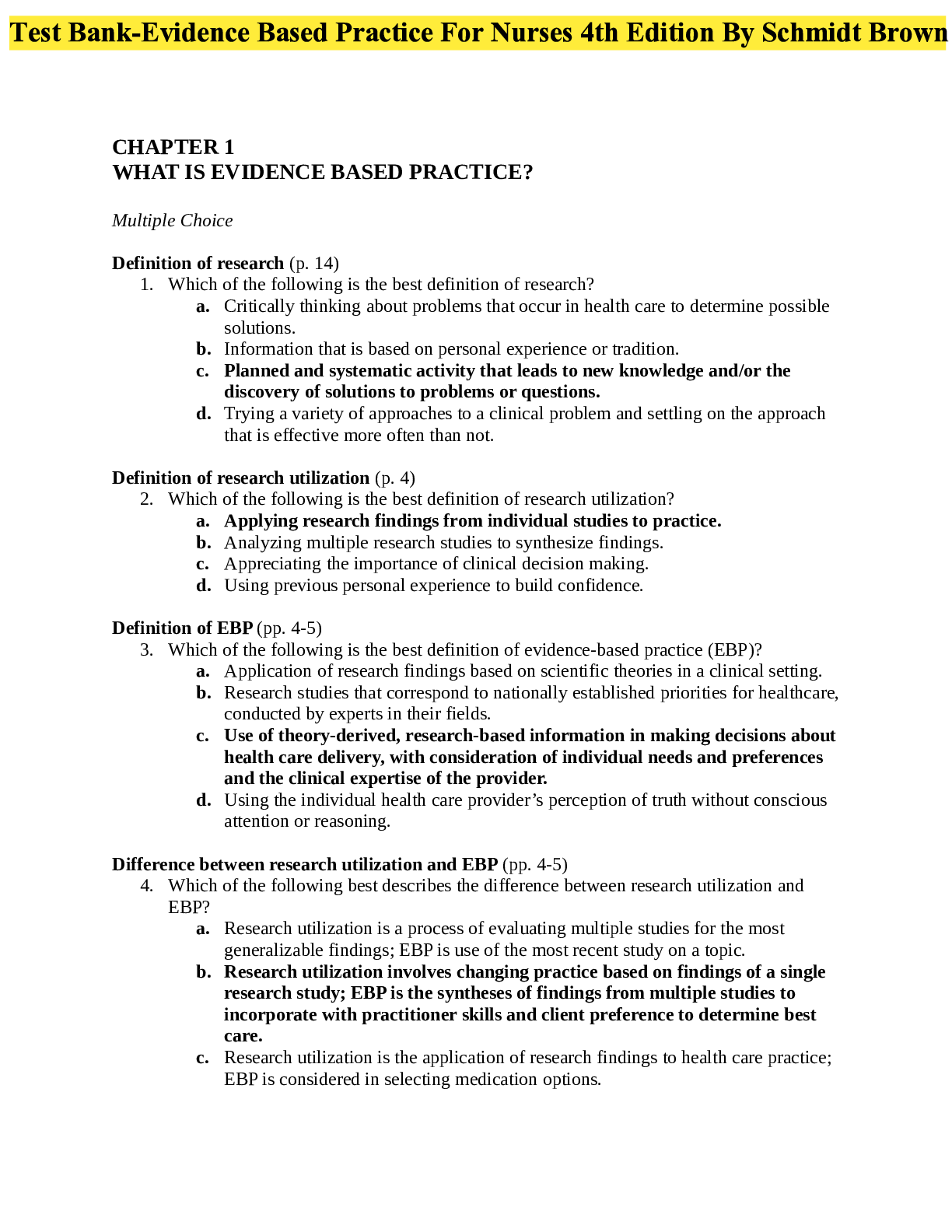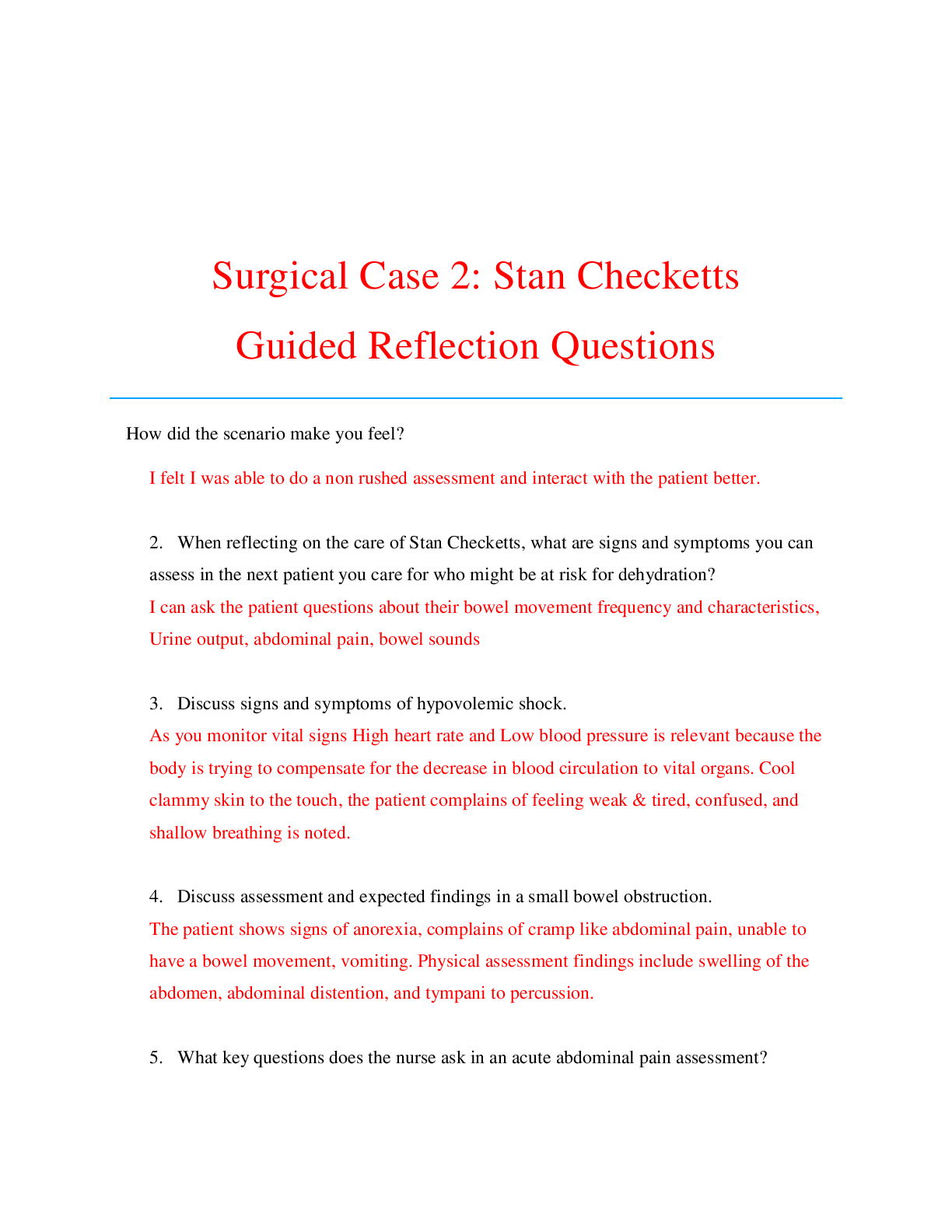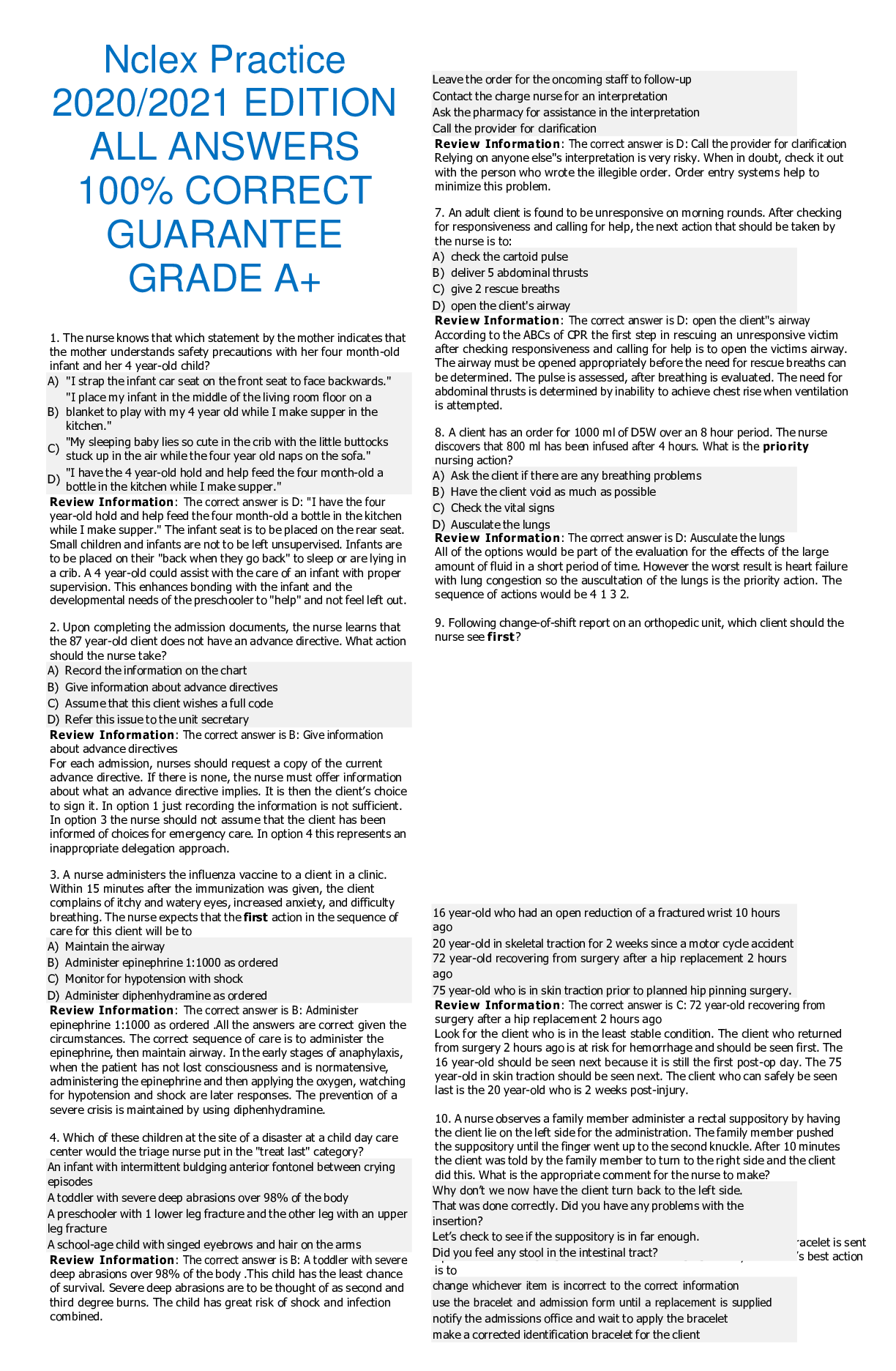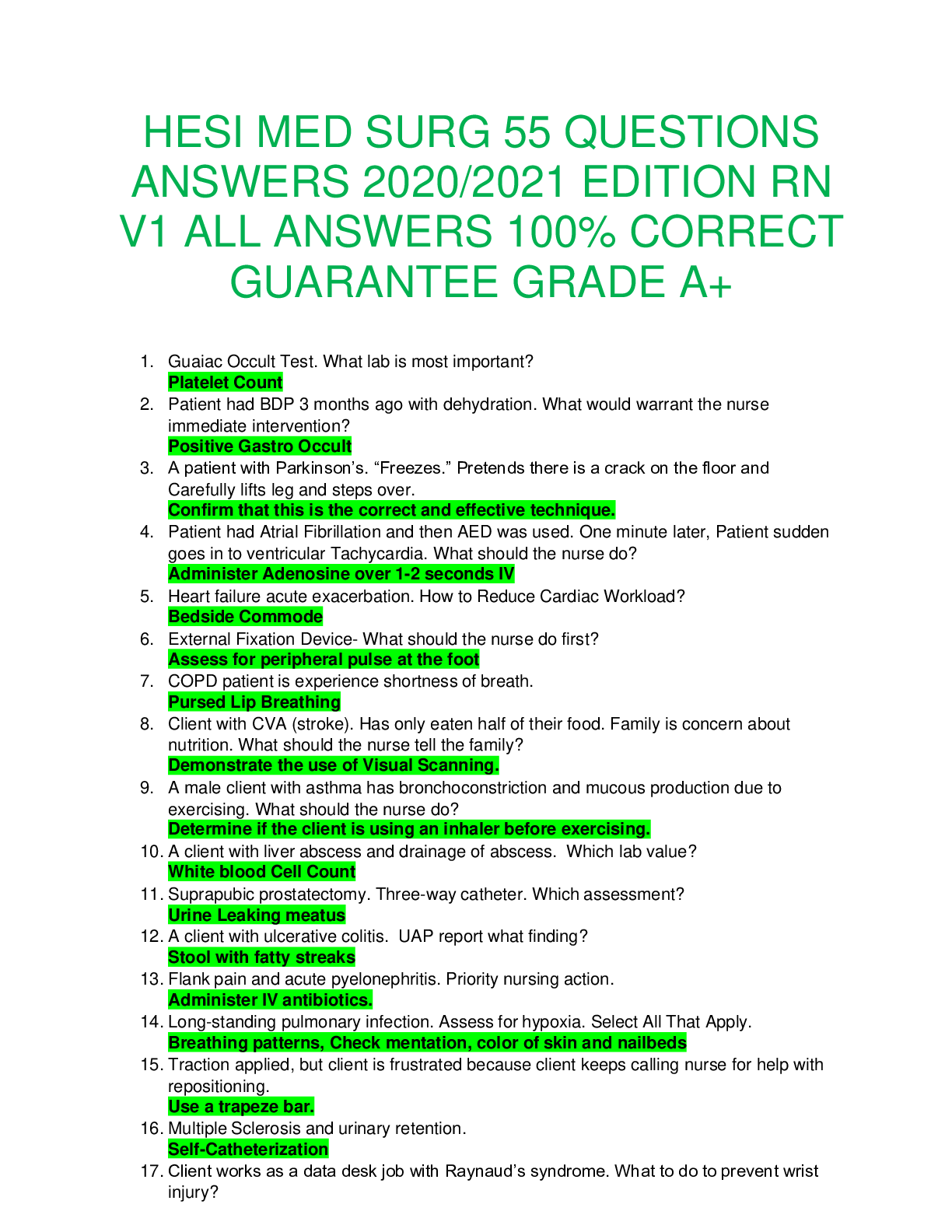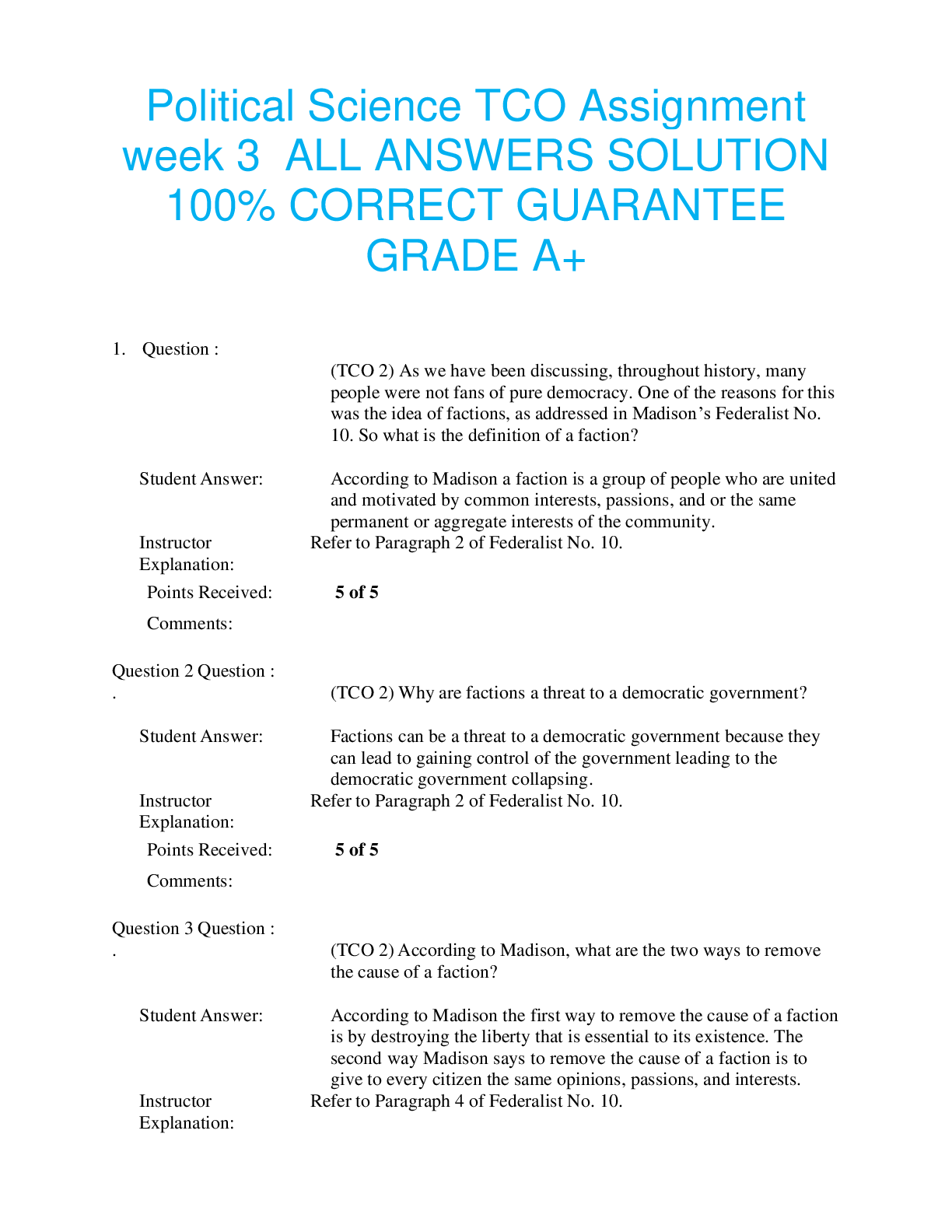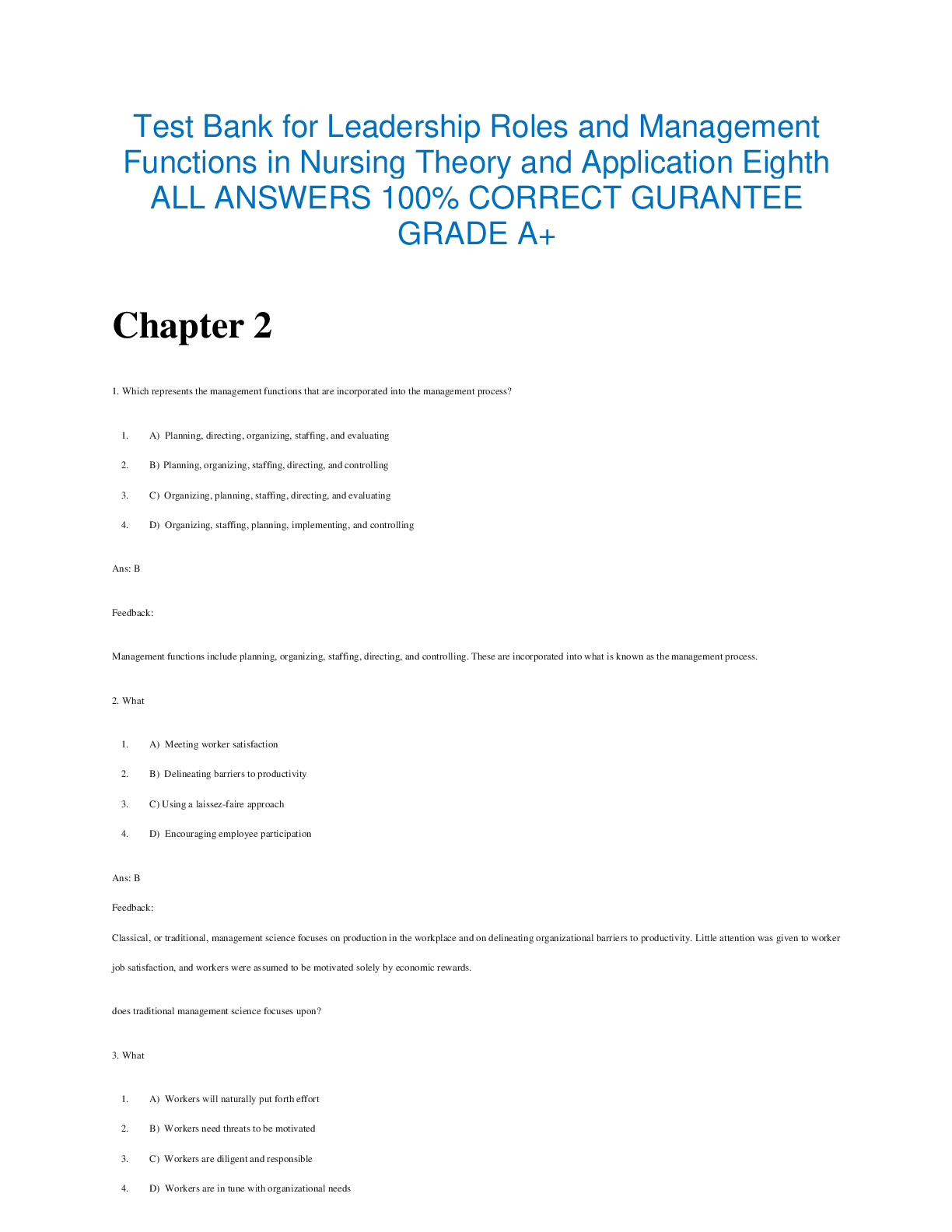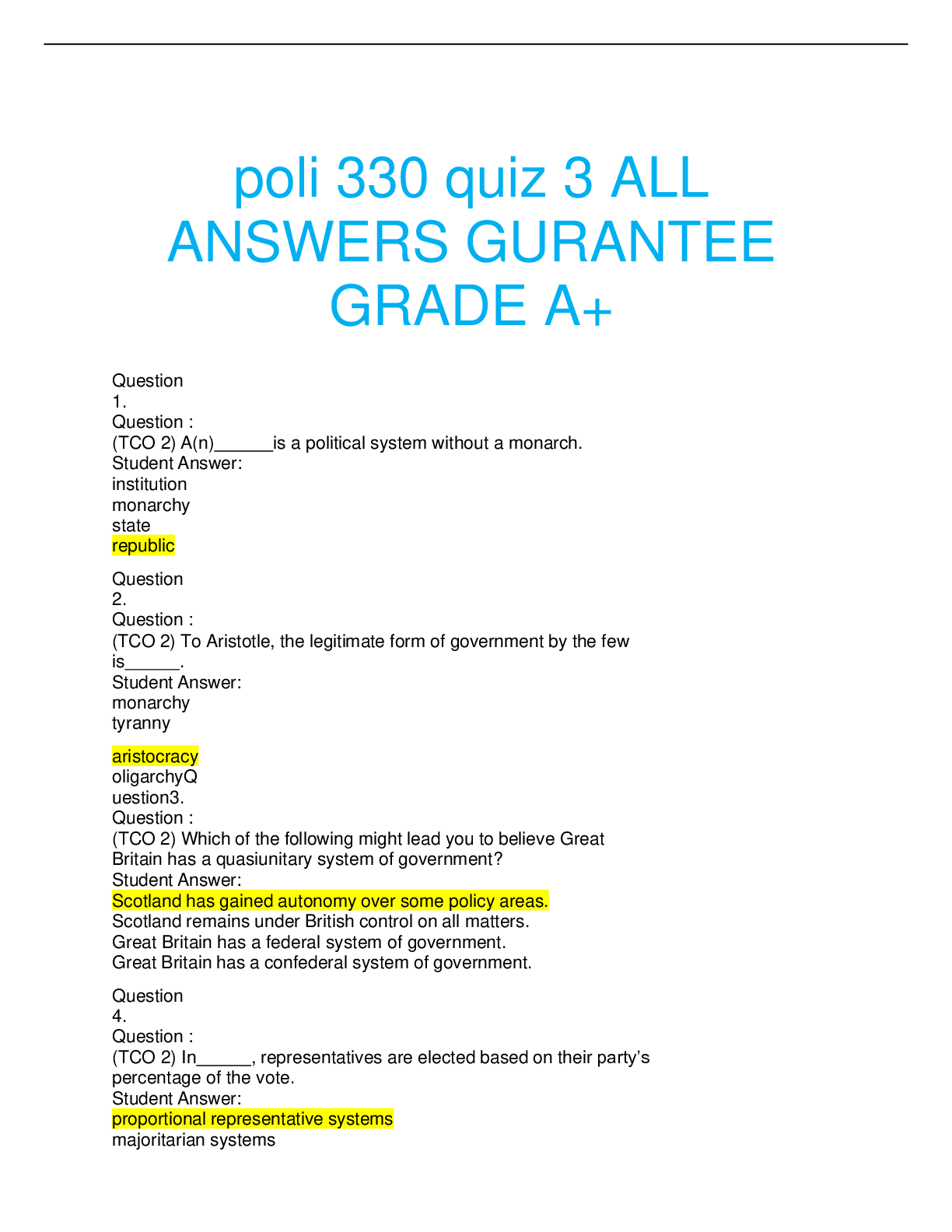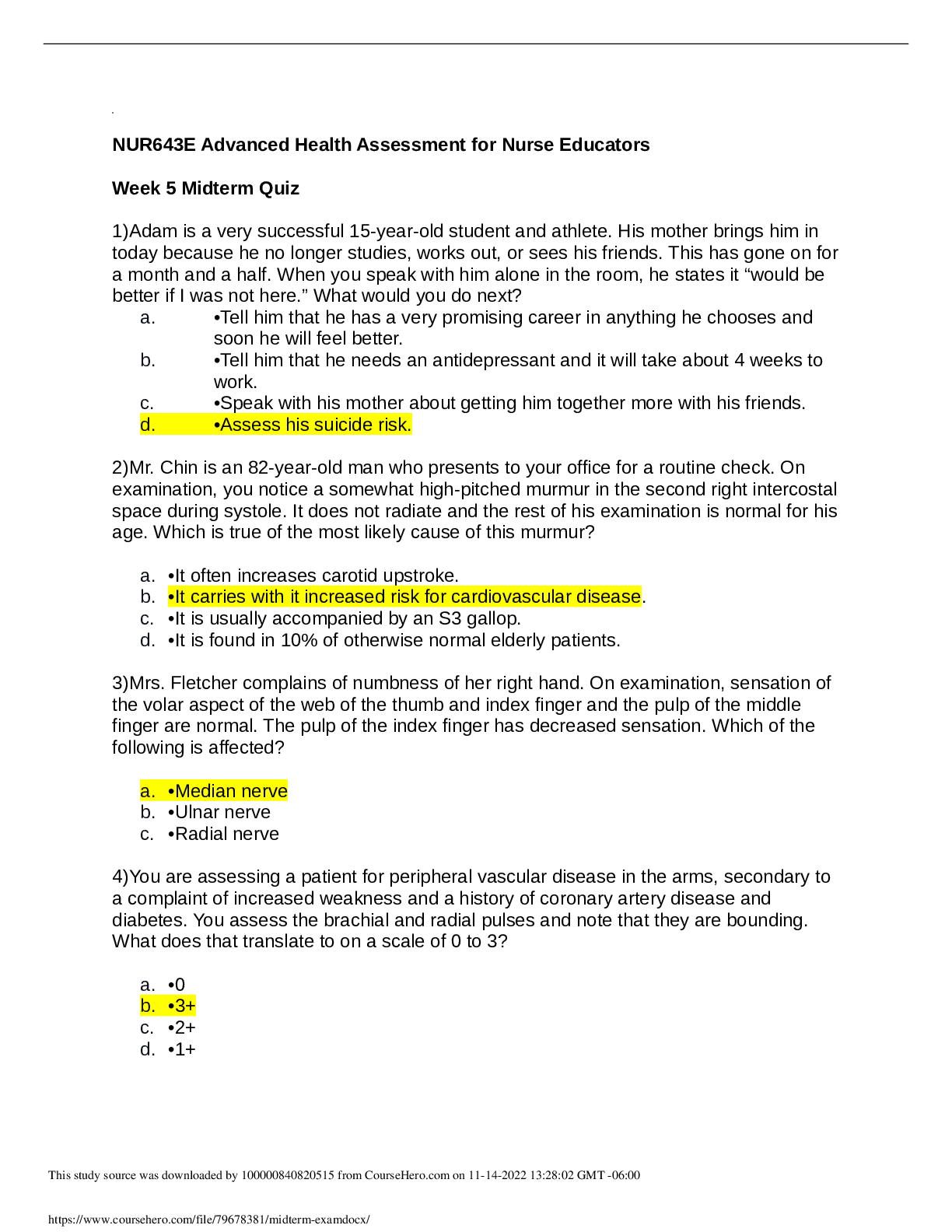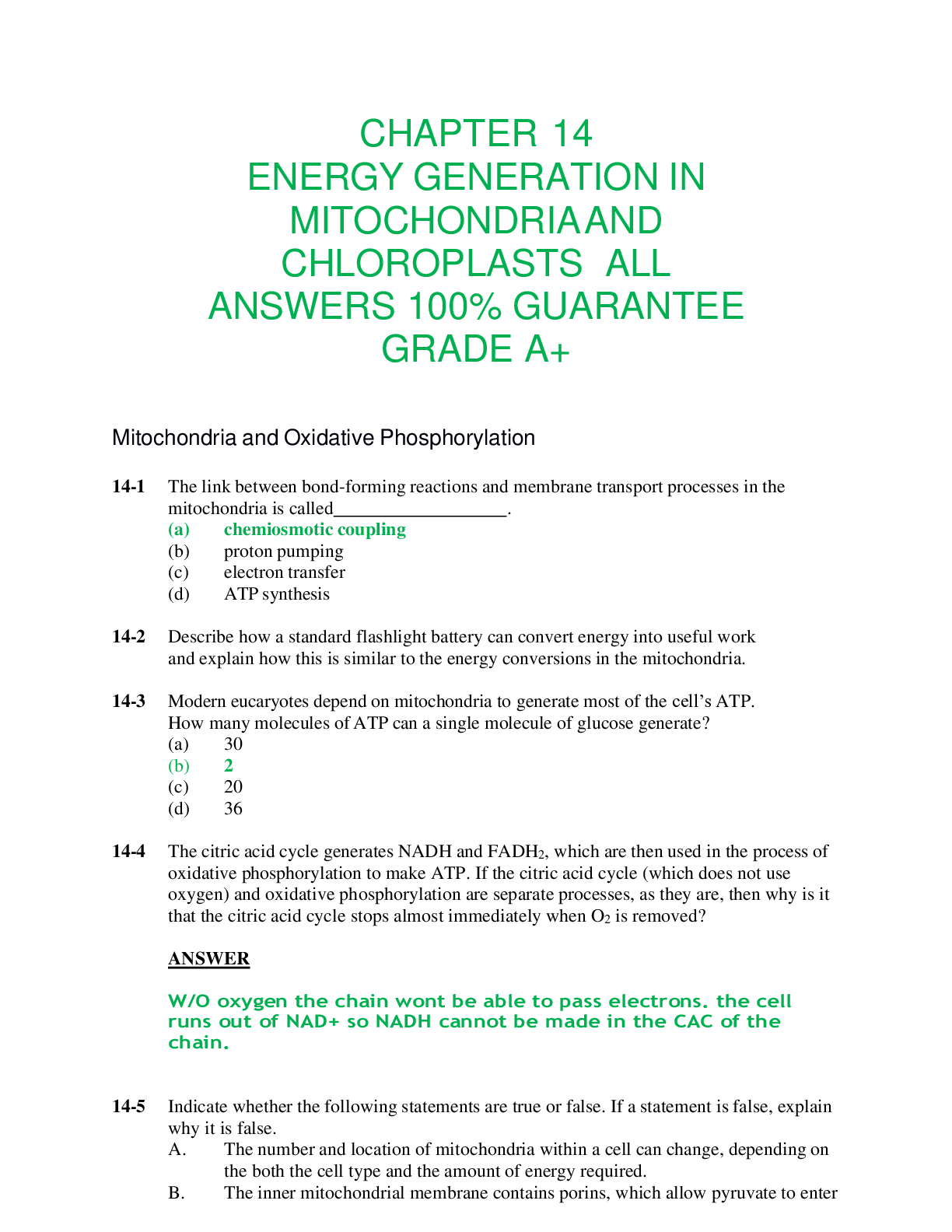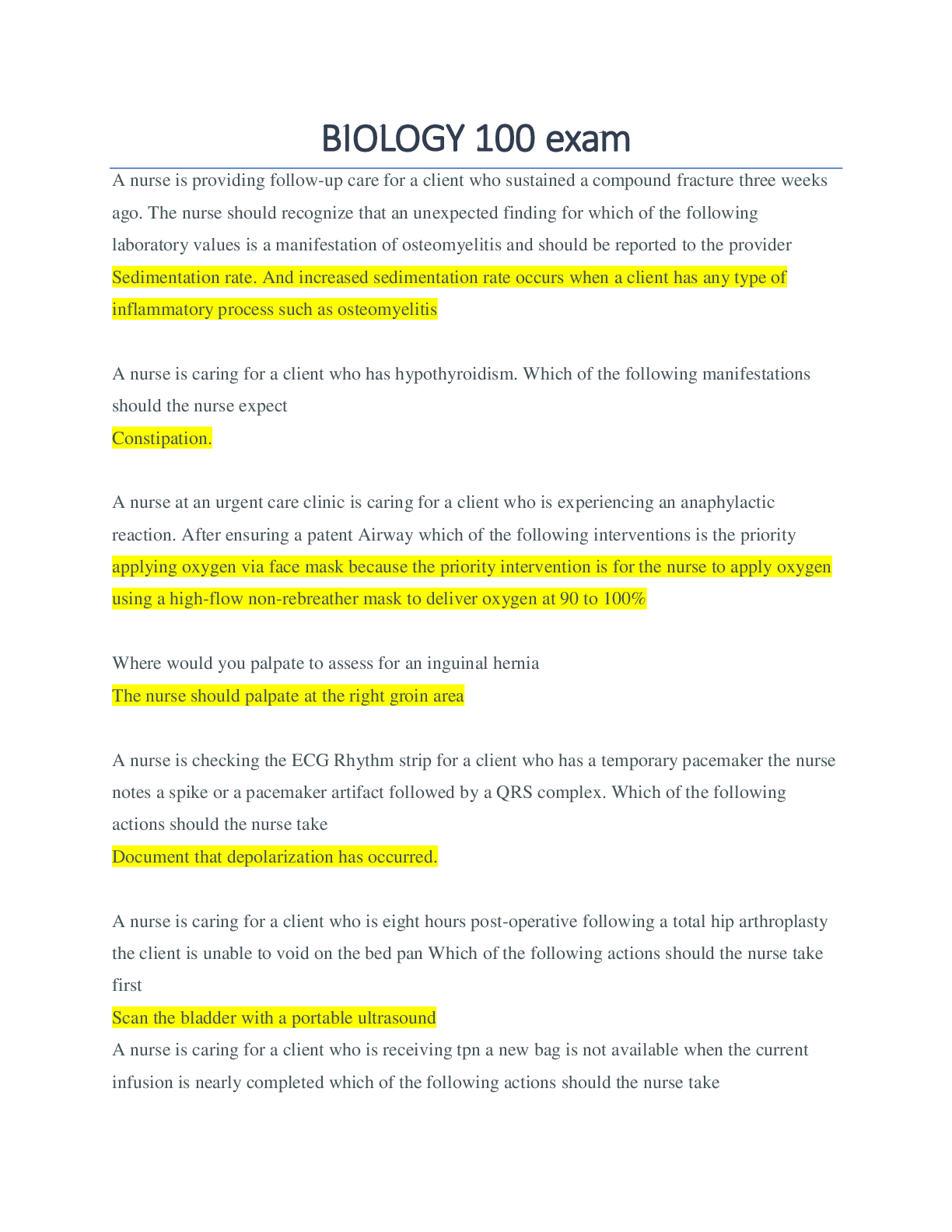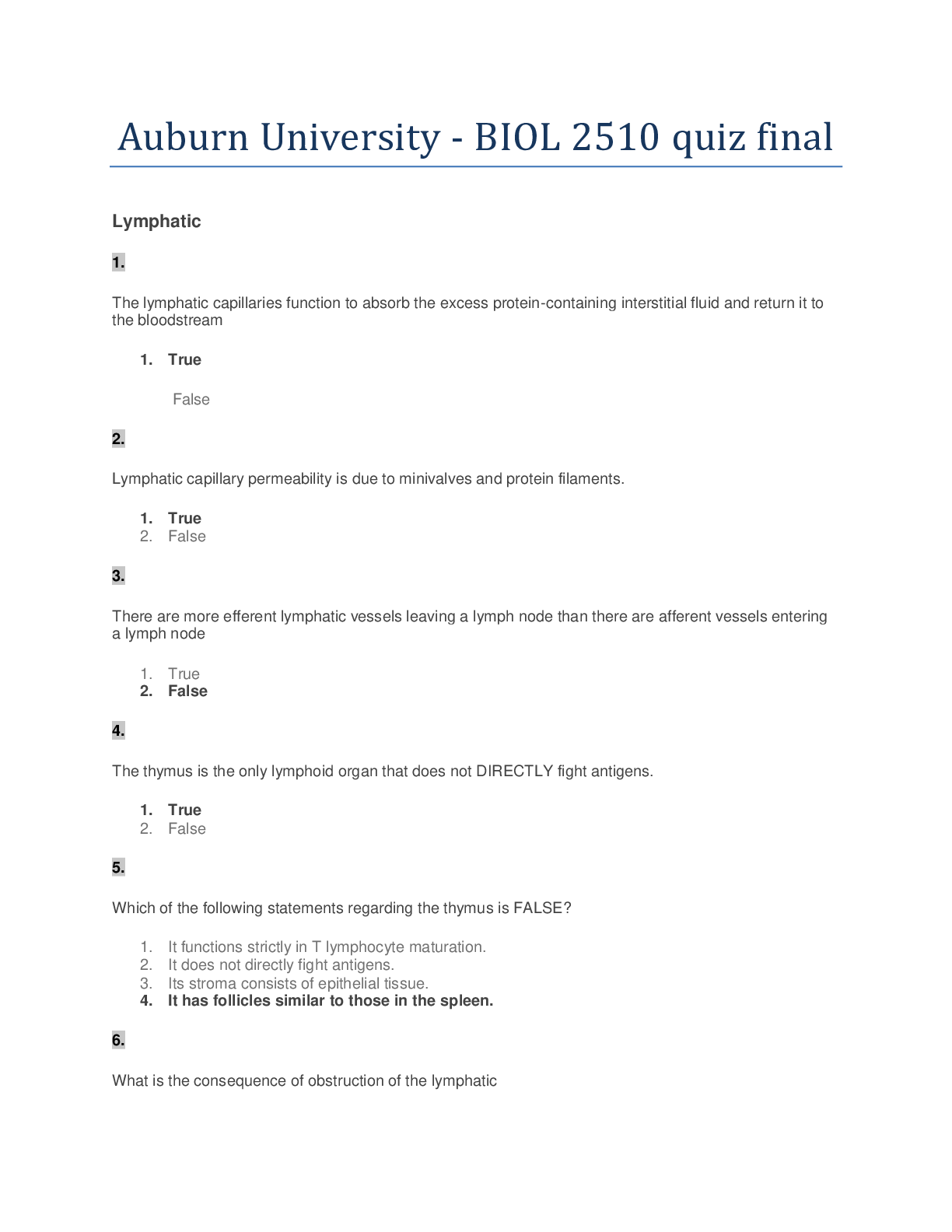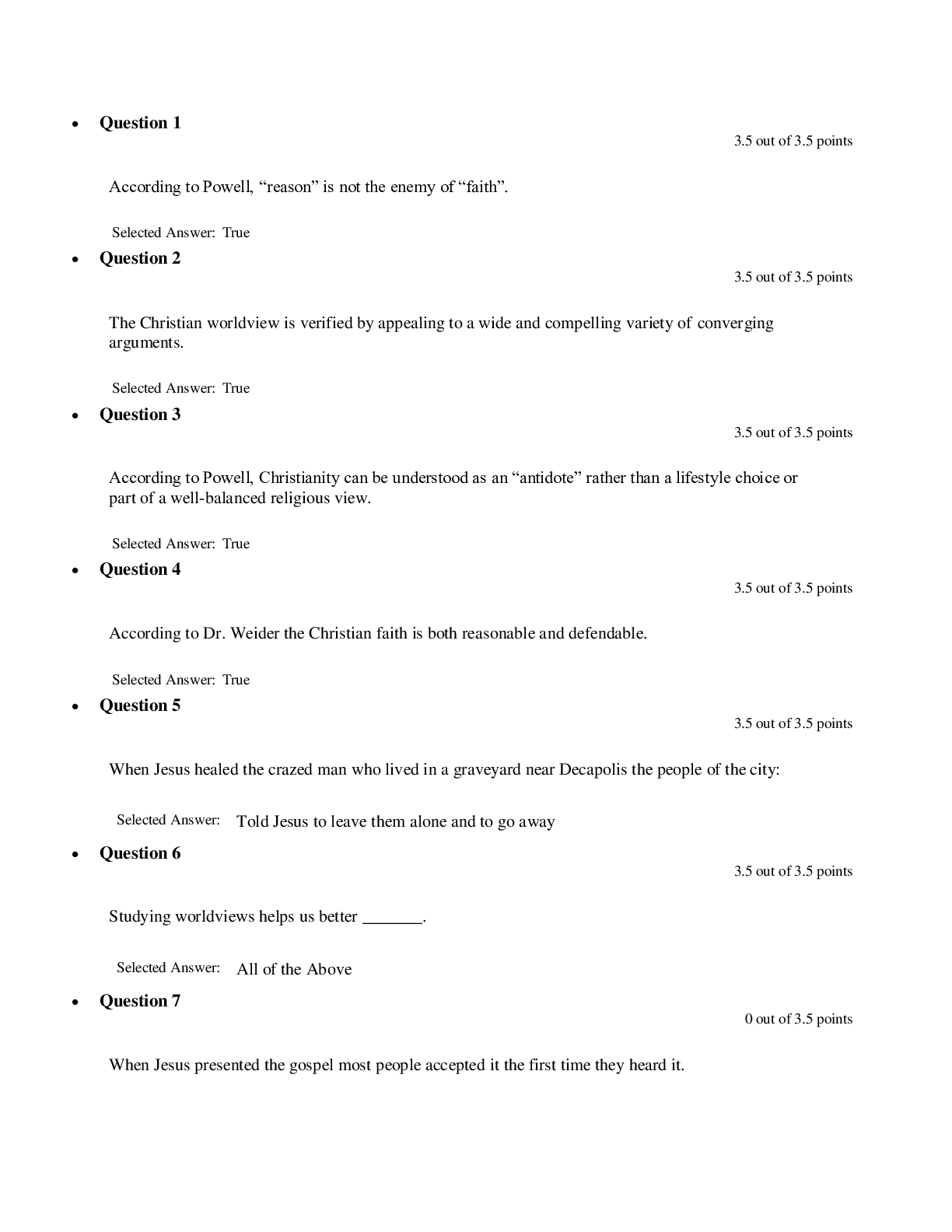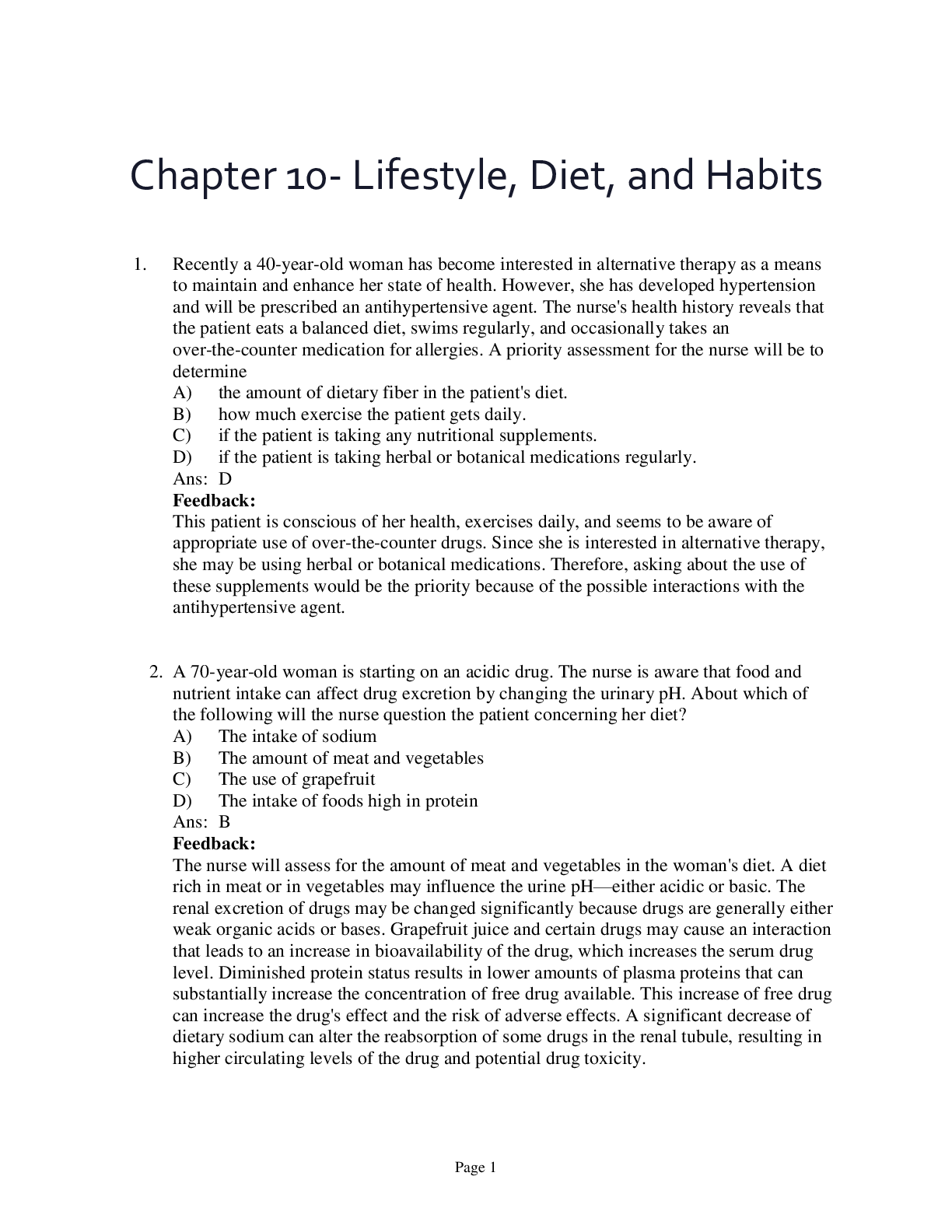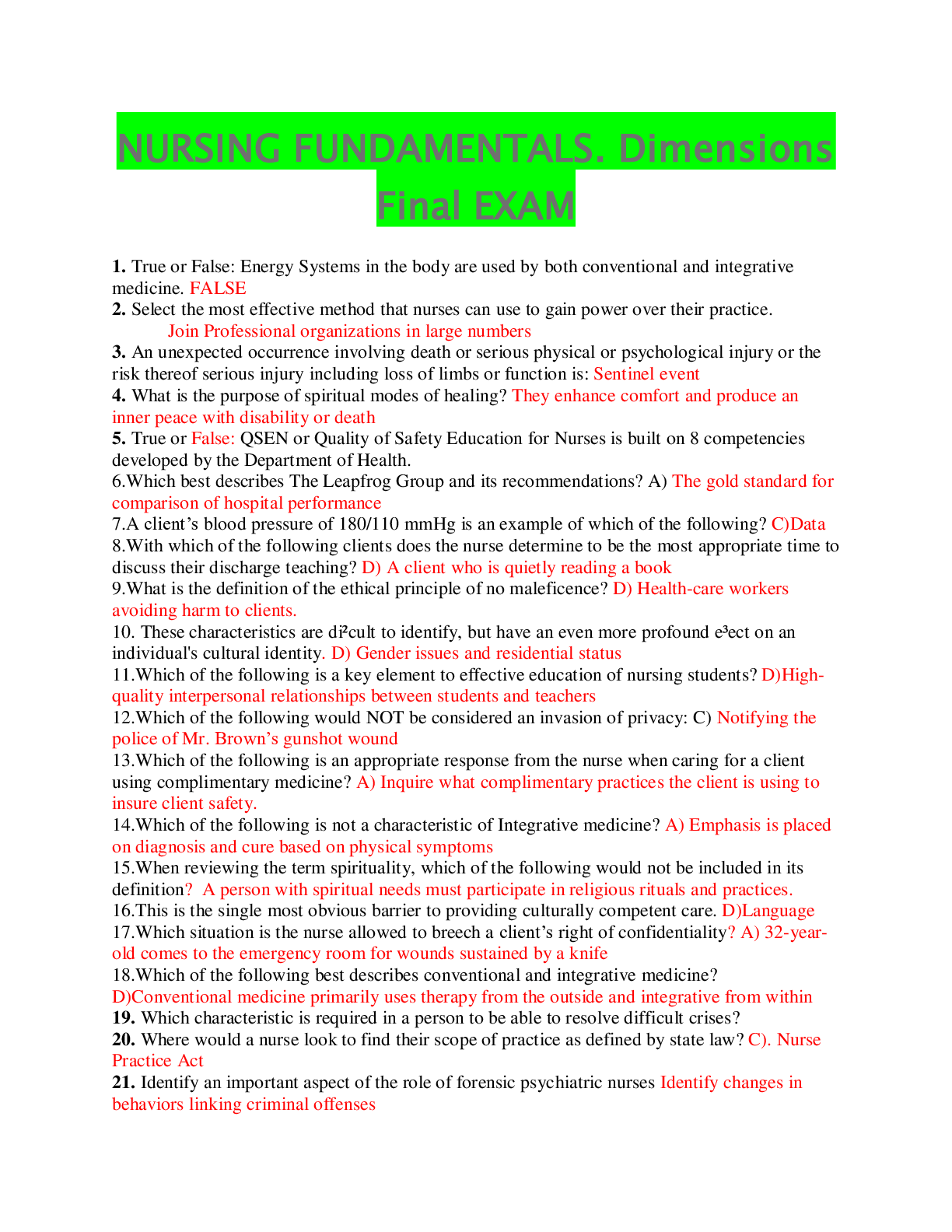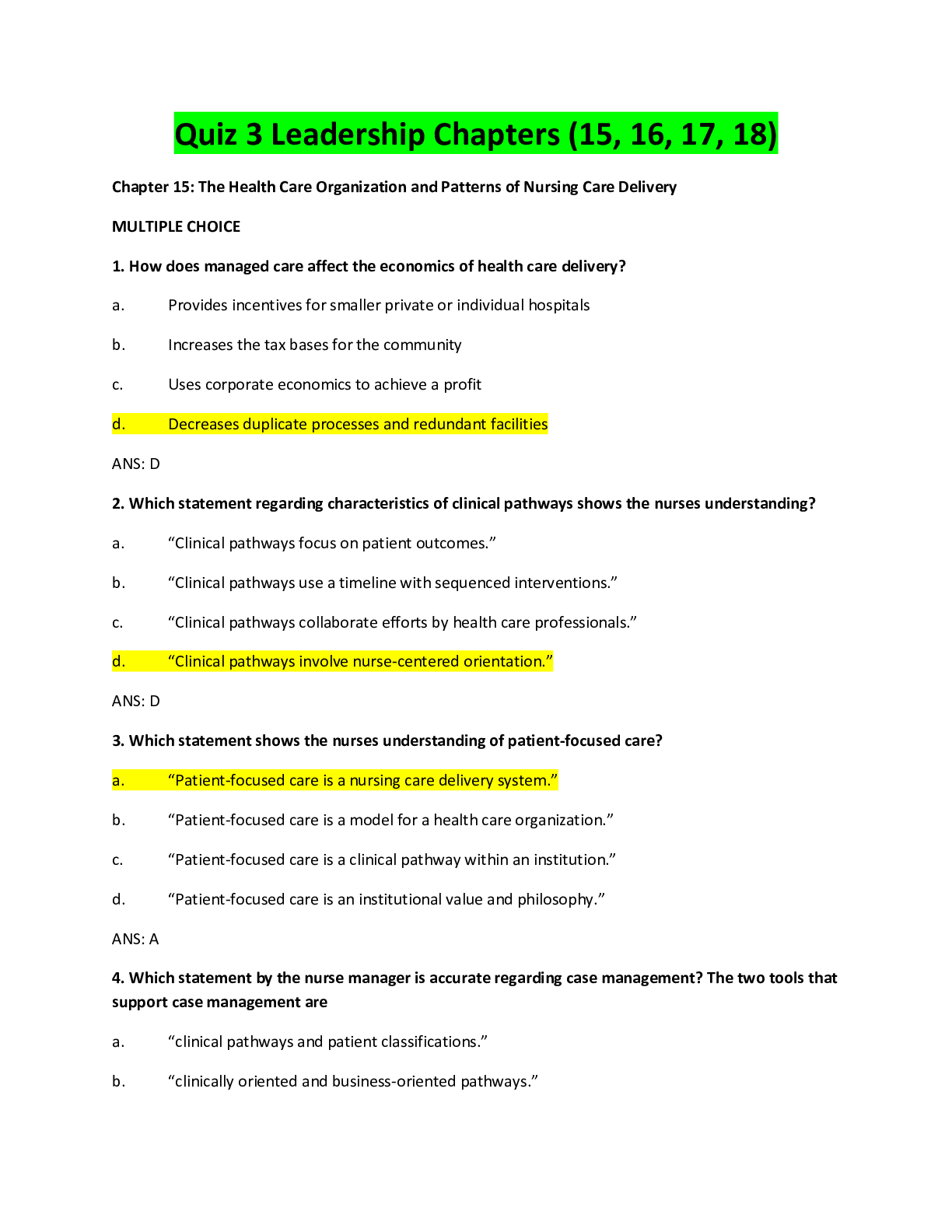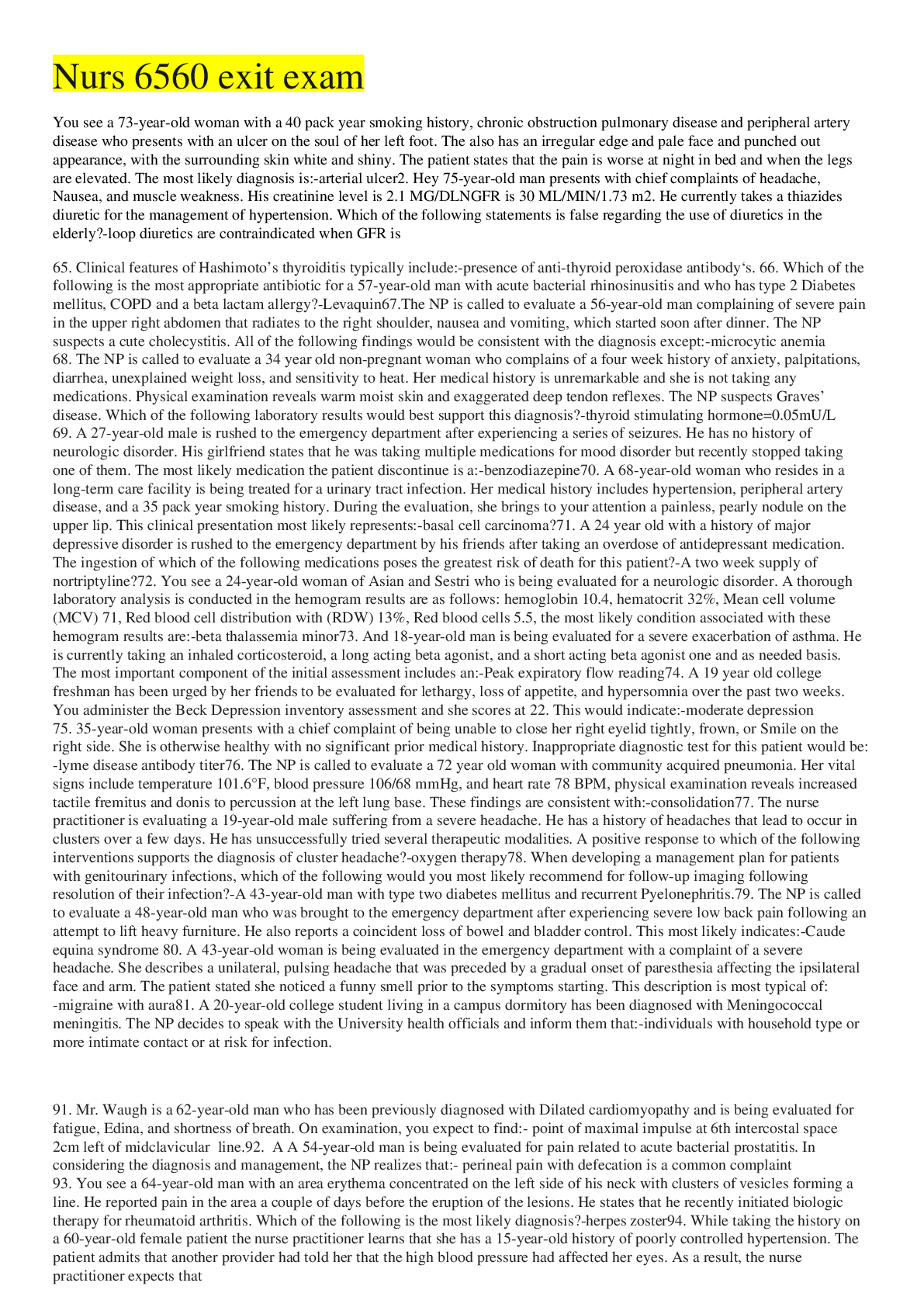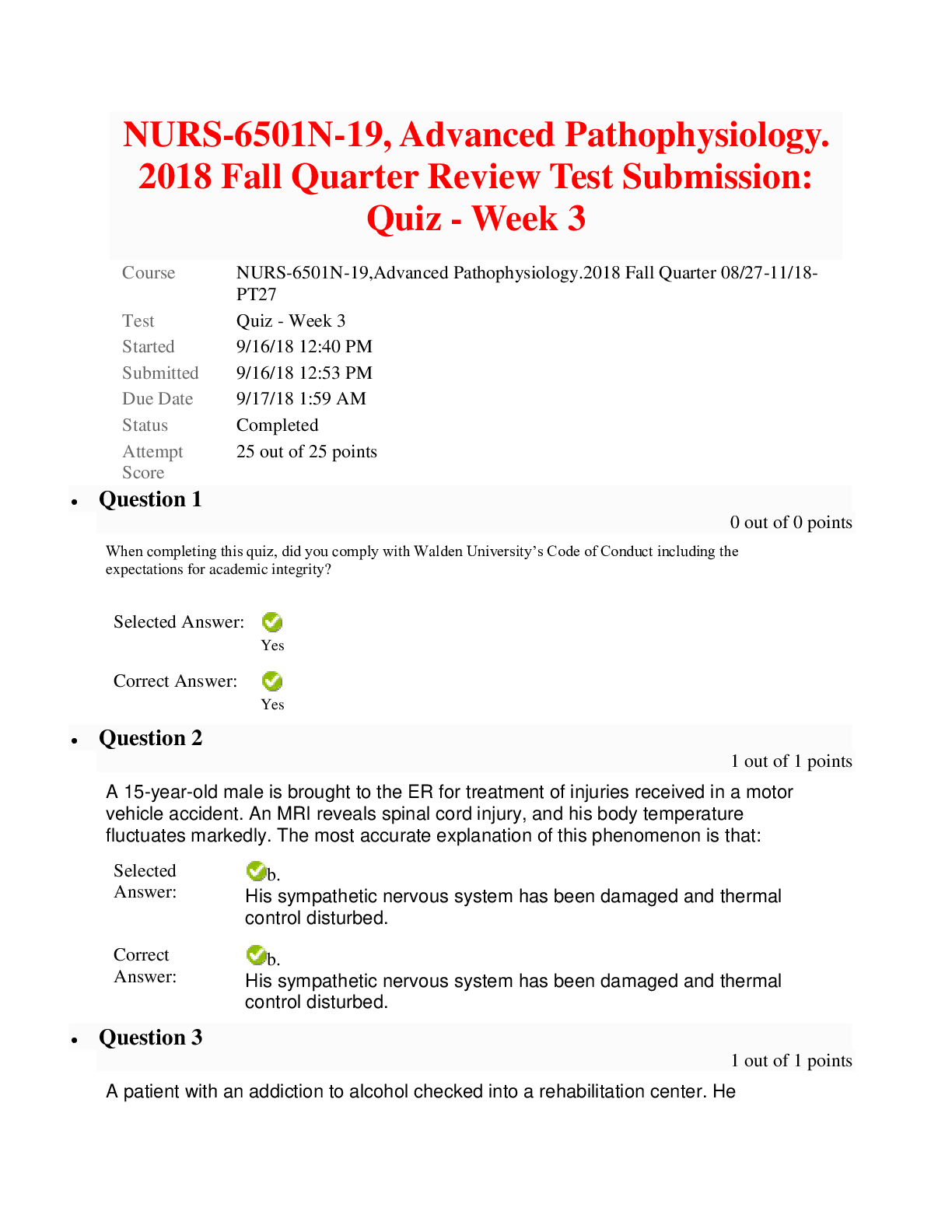*NURSING > QUESTIONS & ANSWERS > A.H Chapter 1: Professional Nursing Practice MULTIPLE CHOICE 100% correct answers aid grade A (All)
A.H Chapter 1: Professional Nursing Practice MULTIPLE CHOICE 100% correct answers aid grade A
Document Content and Description Below
A.H Chapter 1: Professional Nursing Practice MULTIPLE CHOICE 100% correct answers aid grade A 1. The nurse completes an admission database and explains that the plan of care and discharge goal... s will be developed with the patient’s input. The patient states, “How is this different from what the doctor does?” Which response would be most appropriate for the nurse to make? a. “The role of the nurse is to administer medications and other treatments pre-scribed by your doctor.” b. “The nurse’s job is to help the doctor by collecting information and communicating any problems that occur.” c. “Nurses perform many of the same pro-cedures as the doctor, but nurses are with the patients for a longer time than the doctor.” d. “In addition to caring for you while you are sick, the nurses will assist you to de-velop an individualized plan to maintain your health.” . DIF: Cognitive Level: Understand (comprehension) REF: 3 TOP: Nursing Process: Implementation MSC: NCLEX: Safe and Effective Care Environment 2. The nurse describes to a student nurse how to use evidence-based practice guidelines when caring for patients. Which statement, if made by the nurse, would be the most accurate? a. “Inferences from clinical research studies are used as a guide.” b. “Patient care is based on clinical judg-ment, experience, and traditions.” c. “Data are evaluated to show that the pa-tient outcomes are consistently met.” d. “Recommendations are based on research, clinical expertise, and patient preferences.” ANS: D Evidence-based practice (EBP) is the use of the best research-based evidence combined with cli-nician expertise. Clinical judgment based on the nurse’s clinical experience is part of EBP, but clinical decision making should also incorporate current research and research-based guidelines. Evaluation of patient outcomes is important, but interventions should be based on research from randomized control studies with a large number of subjects. DIF: Cognitive Level: Remember (knowledge) REF: 11 TOP: Nursing Process: Planning MSC: NCLEX: Safe and Effective Care Environment 3. The nurse teaches a student nurse about how to apply the nursing process when providing patient care. Which statement, if made by the student nurse, indicates that teaching was successful? a. “The nursing process is a scientific-based method of diagnosing the patient’s health care problems.” b. “The nursing process is a problem-solving tool used to identify and treat patients’ health care needs.” c. “The nursing process is based on nursing theory that incorporates the biopsychoso-cial nature of humans.” d. “The nursing process is used primarily to explain nursing interventions to other health care professionals.” DIF: Cognitive Level: Understand (comprehension) REF: 7 TOP: Nursing Process: Implementation MSC: NCLEX: Safe and Effective Care Environment 4. A patient has been admitted to the hospital for surgery and tells the nurse, “I do not feel comfortable leaving my children with my parents.” Which action should the nurse take next? a. Reassure the patient that these feelings are common for parents. b. Have the patient call the children to ensure that they are doing well. c. Gather more data about the patient’s feel-ings about the child-care arrangements. d. Call the patient’s parents to determine whether adequate child care is being pro-vided. . DIF: Cognitive Level: Apply (application) REF: 6-7 OBJ: Special Questions: Prioritization TOP: Nursing Process: Assessment MSC: NCLEX: Psychosocial Integrity 5. A patient who is paralyzed on the left side of the body after a stroke develops a pressure ulcer on the left hip. Which nursing diagnosis is most appropriate? a. Impaired physical mobility related to left-sided paralysis b. Risk for impaired tissue integrity related to left-sided weakness c. Impaired skin integrity related to altered circulation and pressure d. Ineffective tissue perfusion related to ina-bility to move independently DIF: Cognitive Level: Apply (application) REF: 7-9 TOP: Nursing Process: Diagnosis MSC: NCLEX: Physiological Integrity 6. A patient with a bacterial infection has a nursing diagnosis of deficient fluid volume related to excessive diaphoresis. Which outcome would the nurse recognize as most appropriate for this pa-tient? a. Patient has a balanced intake and output. b. Patient’s bedding is changed when it be-comes damp. c. Patient understands the need for increased fluid intake. d. Patient’s skin remains cool and dry throughout hospitalization. . DIF: Cognitive Level: Apply (application) REF: 7-9 TOP: Nursing Process: Planning MSC: NCLEX: Physiological Integrity 7. A nurse asks the patient if pain was relieved after receiving medication. What is the purpose of the evaluation phase of the nursing process? a. To determine if interventions have been effective in meeting patient outcomes b. To document the nursing care plan in the progress notes of the medical record c. To decide whether the patient’s health problems have been completely resolved d. To establish if the patient agrees that the nursing care provided was satisfactory DIF: Cognitive Level: Understand (comprehension) REF: 7-9 TOP: Nursing Process: Evaluation MSC: NCLEX: Safe and Effective Care Environment 8. The nurse interviews a patient while completing the health history and physical examination. What is the purpose of the assessment phase of the nursing process? a. To teach interventions that relieve health problems b. To use patient data to evaluate patient care outcomes c. To obtain data with which to diagnose patient problems d. To help the patient identify realistic out-comes for health problems DIF: Cognitive Level: Understand (comprehension) REF: 7-9 TOP: Nursing Process: Assessment MSC: NCLEX: Safe and Effective Care Environment 9. Which nursing diagnosis statement is written correctly? a. Altered tissue perfusion related to heart failure b. Risk for impaired tissue integrity related to sacral redness c. Ineffective coping related to response to biopsy test results d. Altered urinary elimination related to uri-nary tract infection DIF: Cognitive Level: Understand (comprehension) REF: 7 TOP: Nursing Process: Diagnosis MSC: NCLEX: Safe and Effective Care Environment 10. The nurse admits a patient to the hospital and develops a plan of care. What components should the nurse include in the nursing diagnosis statement? a. The problem and the suggested patient goals or outcomes b. The problem with possible causes and the planned interventions c. The problem, its cause, and objective data that support the problem d. The problem with an etiology and the signs and symptoms of the problem DIF: Cognitive Level: Remember (knowledge) REF: 8-9 TOP: Nursing Process: Diagnosis MSC: NCLEX: Safe and Effective Care Environment 11. A nurse is caring for a patient with heart failure. Which task is appropriate for the nurse to delegate to experienced unlicensed assistive personnel (UAP)? a. Monitor for shortness of breath or fatigue after ambulation. b. Instruct the patient about the need to al-ternate activity and rest. c. Obtain the patient’s blood pressure and pulse rate after ambulation. d. Determine whether the patient is ready to increase the activity level. DIF: Cognitive Level: Apply (application) REF: 15 OBJ: Special Questions: Delegation TOP: Nursing Process: Planning MSC: NCLEX: Safe and Effective Care Environment 12. A nurse is caring for a group of patients on the medical-surgical unit with the help of one float registered nurse (RN), one unlicensed assistive personnel (UAP), and one licensed practi-cal/vocational nurse (LPN/LVN). Which assignment, if delegated by the nurse, would be inap-propriate? a. Measurement of a patient’s urine output by UAP b. Administration of oral medications by LPN/LVN c. Check for the presence of bowel sounds and flatulence by UAP d. Care of a patient with diabetes by RN who usually works on the pediatric unit DIF: Cognitive Level: Apply (application) REF: 15-16 OBJ: Special Questions: Delegation TOP: Nursing Process: Planning MSC: NCLEX: Safe and Effective Care Environment 13. Which task is appropriate for the nurse to delegate to a licensed practical/vocational nurse (LPN/LVN)? a. Complete the initial admission assessment and plan of care. b. Document teaching completed before a diagnostic procedure. c. Instruct a patient about low-fat, reduced sodium dietary restrictions. d. Obtain bedside blood glucose on a patient before insulin administration. DIF: Cognitive Level: Apply (application) REF: 15-16 OBJ: Special Questions: Delegation TOP: Nursing Process: Planning MSC: NCLEX: Safe and Effective Care Environment 14. A nurse is assigned as a case manager for a hospitalized patient with a spinal cord injury. The patient can expect the nurse functioning in this role to perform which activity? a. Care for the patient during hospitalization for the injuries. b. Assist the patient with home care activities during recovery. c. Determine what medical care the patient needs for optimal rehabilitation. d. Coordinate the services that the patient receives in the hospital and at home. DIF: Cognitive Level: Apply (application) REF: 15 TOP: Nursing Process: Implementation MSC: NCLEX: Safe and Effective Care Environment 15. The nurse is caring for an older adult patient who had surgery to repair a fractured hip. The patient needs continued nursing care and physical therapy to improve mobility before returning home. The nurse will help to arrange for transfer of this patient to which facility? a. A skilled care facility b. A residential care facility c. A transitional care facility d. An intermediate care facility DIF: Cognitive Level: Apply (application) REF: eTable 1-1 | eTable 1-2 | eTable 1-3 TOP: Nursing Process: Plan-ning MSC: NCLEX: Safe and Effective Care Environment 16. A home care nurse is planning care for a patient who has just been diagnosed with type 2 diabetes mellitus. Which task is appropriate for the nurse to delegate to the home health aide? a. Assist the patient to choose appropriate foods. b. Help the patient with a daily bath and oral care. c. Check the patient’s feet for signs of breakdown. d. Teach the patient how to monitor blood glucose. Assessment of the patient and instructing the patient in new skills, such as diet and blood glucose monitoring, are complex skills that are included in registered nurse education and scope of prac-tice. DIF: Cognitive Level: Apply (application) REF: 14 OBJ: Special Questions: Delegation TOP: Nursing Process: Implementation MSC: NCLEX: Safe and Effective Care Environment 17. The nurse is providing education to nursing staff on quality care initiatives. Which statement would be the most accurate description of the impact of health care financing on quality care? a. “Hospitals are reimbursed for all costs in-curred if care is documented electronical-ly.” b. “Payment for patient care is primarily based on clinical outcomes and patient satisfaction.” c. “If a patient develops a catheter-related infection, the hospital receives additional funding.” d. “Because hospitals are accountable for overall care, it is not nursing’s responsibil-ity to monitor care delivered by others.” ANS: B Payment for health care services programs reimburses hospitals for their performance on overall quality-of-care measures. These measures include clinical outcomes and patient satisfaction. Nurses are responsible for coordinating complex aspects of patient care, including the care deliv-ered by others, and identifying issues that are associated with poor quality care. Payment for care can be withheld if something happens to the patient that is considered preventable (e.g., acquir-ing a catheter-related urinary tract infection). DIF: Cognitive Level: Apply (application) REF: 4-5 TOP: Nursing Process: Implementation MSC: NCLEX: Safe and Effective Care Environment 18. The nurse documenting the patient’s progress in the care plan in the electronic health record before an interdisciplinary discharge conference is demonstrating competency in which QSEN category? a. Patient-centered care b. Quality improvement c. Evidence-based practice d. Informatics and technology . DIF: Cognitive Level: Apply (application) REF: 5 | 10-11 TOP: Nursing Process: Implementation MSC: NCLEX: Safe and Effective Care Environment MULTIPLE RESPONSE 1. Which information will the nurse consider when deciding what nursing actions to delegate to a licensed practical/vocational nurse (LPN/LVN) who is working on a medical-surgical unit (select all that apply)? a. Institutional policies b. Stability of the patient c. State nurse practice act d. LPN/LVN teaching abilities e. Experience of the LPN/LVN ANS: A, B, C, E The nurse should assess the experience of LPN/LVNs when delegating. In addition, state nurse practice acts and institutional policies must be considered. In general, LPN/LVN scope of prac-tice includes caring for patients who are stable, while registered nurses should provide most of the care for unstable patients. Since LPN/LVN scope of practice does not include patient educa-tion, this will not be part of the delegation process. DIF: Cognitive Level: Apply (application) REF: 14 OBJ: Special Questions: Delegation TOP: Nursing Process: Planning MSC: NCLEX: Safe and Effective Care Environment 2. The nurse is administering medications to a patient. Which actions by the nurse during this process are consistent with promoting safe delivery of care (select all that apply)? a. Throws away a medication that is not la-beled b. Uses a hand sanitizer before preparing a medication c. Identifies the patient by the room number on the door d. Checks lab test results before administer-ing a diuretic e. Gives the patient a list of current medica-tions upon discharge . DIF: Cognitive Level: Apply (application) REF: 15-16 TOP: Nursing Process: Implementation MSC: NCLEX: Safe and Effective Care Environment OTHER 1. The nurse uses the Situation-Background-Assessment-Recommendation (SBAR) format to communicate a change in patient status to a health care provider. In which order should the nurse make the following statements? (Put a comma and a space between each answer choice [A, B, C, D].) a. “The patient needs to be evaluated immediately and may need intubation and mechanical ven-tilation.” b. “The patient was admitted yesterday with heart failure and has been receiving furosemide (Lasix) for diuresis, but urine output has been low.” c. “The patient has crackles audible throughout the posterior chest and the most recent oxygen saturation is 89%. Her condition is very unstable.” d. “This is the nurse on the surgical unit. After assessing the patient, I am very concerned about increased shortness of breath over the past hour.” [Show More]
Last updated: 1 year ago
Preview 1 out of 10 pages
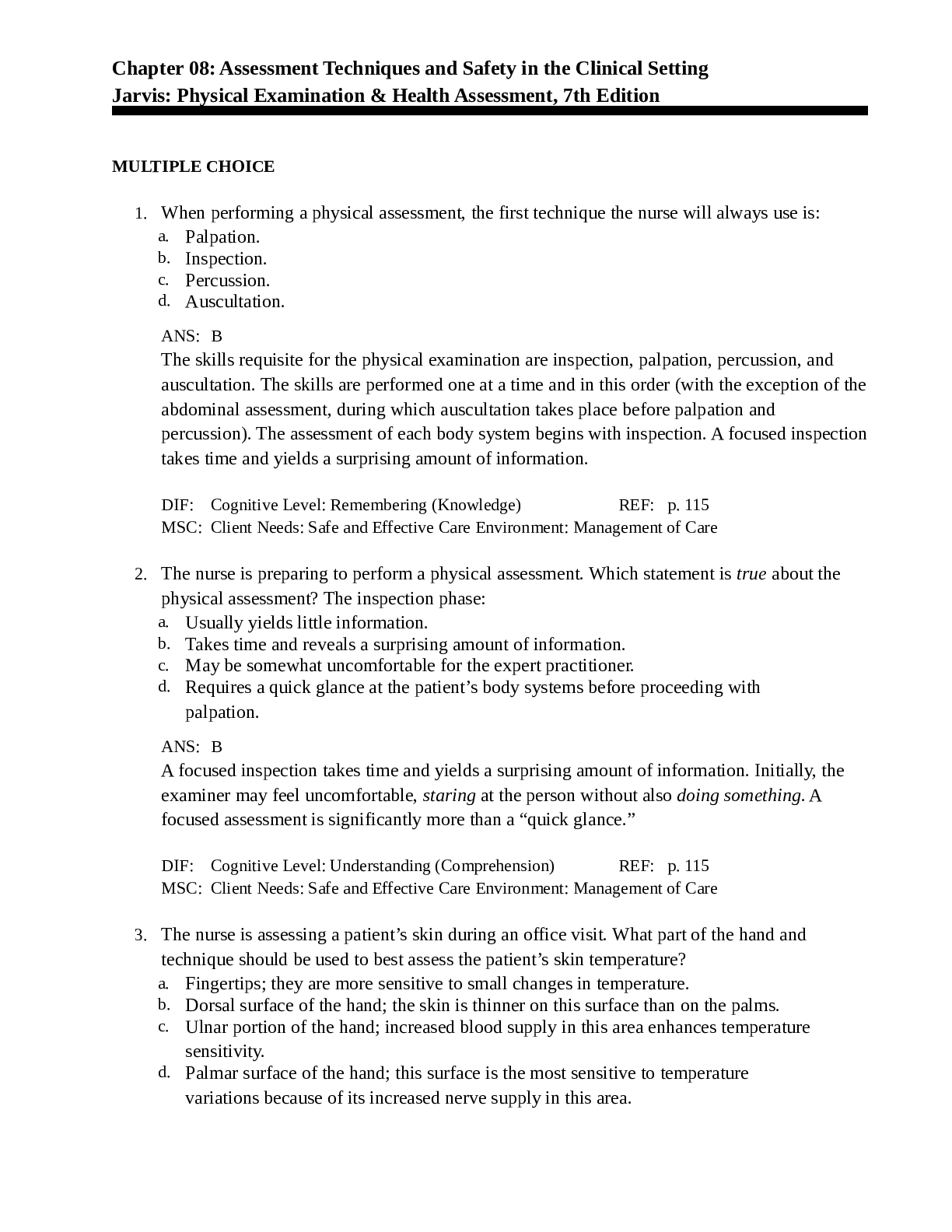
Buy this document to get the full access instantly
Instant Download Access after purchase
Add to cartInstant download
We Accept:

Reviews( 0 )
$14.00
Document information
Connected school, study & course
About the document
Uploaded On
Mar 09, 2021
Number of pages
10
Written in
Additional information
This document has been written for:
Uploaded
Mar 09, 2021
Downloads
0
Views
55

